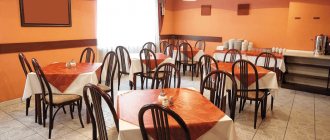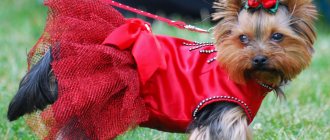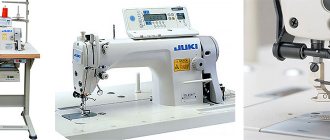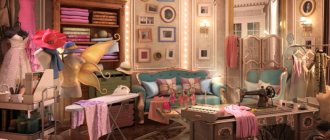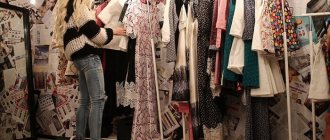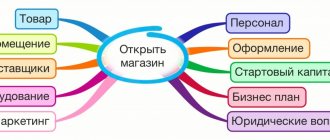The market for designer clothing made in Russia is replenished with new brands every season, without reaching a saturation point and without creating a competitive environment. Three-quarters of players leave the niche after the first year of work, lacking the resources, practical skills, and often inspiration to keep an energy-consuming but low-income business afloat. How to open your own clothing brand, release your first collections and make a profit is described step by step in this instruction.
Market research and buyer profile
The main mistake of novice clothing brand owners is an incorrect understanding of the market structure and buyer requests. This leads to attempts to cover several directions at once, to compete with global chain stores, or, conversely, to create a product with a very narrow focus, which does not allow expanding the range. Marketing research at the initial stage of creating a business will help create a portrait of the buyer, assess the level of competition and outline niche features that will help make the brand unique.
If the size of the initial capital does not allow placing an order for market analysis in a special agency (average cost 30,000–60,000 rubles), then the research is carried out by the entrepreneur. At this stage you should:
- estimate the geography of sales and the approximate number of buyers;
- determine the average age, income, purchasing habits of potential customers;
- identify needs that the market is not able to satisfy and the reasons (economic inefficiency, low demand, complexity of implementation);
- make a list of competitors and research the range, quality, prices, loyalty policy, reviews;
- discover weaknesses in the existing niche structure and make them your main strengths.
The main advantages of local brands over chain brands are unusual design, unique construction, rare fabric, and quality control of each product. You should not try to compete with industry giants in terms of prices, speed of response to fashion trends, coverage of advertising campaigns - these indicators tend to improve with increasing demand for the product, without special expenses on the part of the entrepreneur.
Preparatory stage
At the initial stage, you need to assess the situation on the market and choose your own development path. A business plan includes risks, provides a financial justification for the business and provides a real opportunity to assess the expected benefits.
Concept Definition
It is very important to identify the target audience and direct activities towards the development of specific models:
- sewing outerwear;
- production of casual (men's or women's) clothing;
- sewing underwear, pajamas;
- sewing dresses;
- development of youth clothing;
- sewing men's suits.
At the start, it matters whether the models are intended for a wide audience or positioned as exclusive. In the first case, the bet is made on the contrary, on the number of items sold, in the second - on the high cost of each model.
Market and competition analysis
Example of a table for competitor analysis
Assessing competitors is one of the most difficult and critical stages. An incorrect perception of the market situation will lead to errors in choosing a concept and the inability to occupy your niche. When analyzing the competition, you should pay attention to the companies supplying clothing of the selected format to the region, the variety of styles, affordability, quality and demand.
Marketing research will help you determine priorities and choose the right direction. Clothing from domestic brands is noticeably gaining popularity, so there is no need to be afraid of being in the shadow of popular names, you need to look for your individuality and be able to show off a quality product.
Concept formation and logo development
Having analyzed the information about who will be the buyer of clothing and under what conditions, it is necessary to begin to formulate a brand concept. This stage is necessary for the correct positioning of the company in the market, and therefore for more accurately meeting niche demand. The process of describing a concept is much like conducting market research. Only the object of analysis in this case is the newly created company, and not the client or competitor. Five questions to answer at this stage:
- What kind of clothes do we produce and for whom?
- What are the company's core values and principles?
- What additional needs does the brand’s clothing satisfy? (in prestige, ease of purchase, environmental friendliness of materials, etc.)
- What is the main advantage over your competitors?
- What will make a buyer a repeat customer?
All decisions made in the process of creating a brand must fit into the outlined concept. First of all, this concerns the name, logo and design style of printed materials (look books, labels, labels, stands). In the absence of skills in working with graphic programs and a design vision, the creation of a visual brand concept is entrusted to an agency or freelance artist. From the date of conclusion of the contract to the receipt of the finished graphic product, on average, about 1 month passes, costs - from 20,000 rubles.
How to sew on a machine correctly
Error 7
Failure to read the instructions for using the sewing machine. Before you start sewing, you need to set up your sewing equipment. To ensure straight stitches, you need to regularly lubricate the necessary parts and clean the inside of the machine with a special brush.
Advice from an expert on where to lubricate a sewing machine and how to do it here >>>
Error 8
Do not change needles. Often, a beginning seamstress is faced with the fact that the machine makes poor-quality stitches, loops or skips. It must be borne in mind that for each type of fabric there are certain sizes of sewing needles. They are divided by numbers: 70, 80...110. There are also special needles for stretch fabrics. If you don’t know how to sew knitwear correctly, then the main thing here is to use the right needles. In addition, keep in mind that over time the needles will have to be changed, they may become dull or scratches may form on them - such needles leave snags on the fabric.
Error 9. Time
Sew quickly. When a novice seamstress starts sewing, due to lack of experience and patience, she wants to sew the item quickly, so she skips such important stages in the work as basting. Or leaves uneven lines. You need to not be lazy to use a seam ripper and learn to sew efficiently. There is a misconception - that if a thing is sewn for oneself, then only I can see the wrong side and crooked stitches, so it will do just fine. Train yourself to sew a “beautiful inside out.”
Mistake 10. Trying on
Sew without trying on. In the process of sewing a product, you must definitely try it on; you can skip this step only if the pattern is tailored to your figure and you have already sewn according to these patterns.
Mistake 11. Desire
Leaving an item unfinished. It often happens that a seamstress begins to sew, but then the desire disappears, and the item remains unfinished. Be patient - if something doesn’t work out, try to find your mistakes and correct them. Don't start sewing a new item until you finish the previous one.
Error 12: Tools
Not having the necessary sewing tools on hand >>> Before you start sewing, take the trouble to acquire the most essential sewing tools: tailor's chalk, pins, measuring tape, good fabric scissors, an iron with a steam function. They will make your work easier and save time, and the result will be much better.
Error 13. Ironing
Sew raw fabrics. Ironing or decatching (wet heat treatment) of fabric is a mandatory process before sewing. If you skip this step, then all your efforts may be lost after the first wash of the item. The fabric may shrink and the item will decrease in size.
I hope after reading these mistakes of a novice seamstress, proven from your own experience, you will think about how to sew correctly. And as always, I wish you success in all your creative endeavors and see you again on my blog.
And for those who want to learn cutting and sewing under the guidance of a master, I pass on my knowledge accumulated over many years of experience in my online lessons. Come to my courses and learn to sew correctly!
Business registration and trademark protection
For official work and concluding contracts, it is necessary to register an individual entrepreneur or LLC if there is more than one founders. When filling out the registration form, you should indicate OKVED-2 from the following list:
| 14 | Manufacture of wearing apparel |
| 14.11 | Production of leather clothing |
| 14.12 | Production of workwear |
| 14.13 | Production of other outerwear |
| 14.14 | Production of underwear |
| 14.19 | Production of other clothing and clothing accessories |
| 14.20 | Production of fur products |
| 14.31 | Production of knitted and knitted hosiery |
| 14.39 | Production of other knitted and knitted products |
| 46 | Wholesale trade |
| 46.42 | Wholesale trade of clothing and footwear |
| 47 | Retail trade, except trade in motor vehicles and motorcycles |
| 47.91 | Retail trade by mail or via the Internet information and communication network |
At the same time, you should submit an application for the application of the simplified tax system. Since there will be official costs for the purchase of materials and remuneration of workers, the simplified tax system “Income minus expenses” of 15% seems to be the most profitable. Sometimes it is more effective to use the patent system for the type of activity “Repair and sewing of clothing, fur and leather products, hats and textile haberdashery products, repair, sewing and knitting of knitted products.” The choice of a specific option depends on the region of registration of the legal entity and the number of employees.
The direct name of the clothing brand may have nothing to do with the name of the individual entrepreneur or the name of the LLC, but at the same stage you can also register a trademark with the Patent Office. A registered trademark provides advantages in the form of protection from copying by competitors, free advertising in the media, and the opportunity to launch a franchise.
Self-registration of a patent can take up to six months, and the total cost of state fees is about 40 thousand rubles. The work of commercial structures offering assistance in registration costs at least 10 thousand rubles. Therefore, it is not always advisable to engage in copyright protection at the initial stage, but this will help avoid lawsuits in the future.
Financial component
Average costs for creating your own clothing brand:
- Rent of premises – 400 thousand rubles.
- Business registration – 60 thousand rubles.
- Purchase of equipment – 300 thousand rubles.
- The cost of materials for making clothes is 500 thousand rubles.
- Advertising costs – 150 thousand rubles.
- Salary for employees and taxes – 250 thousand rubles.
Total cost: 1,660,000 thousand rubles.
Income depends on a successful advertising campaign, competition, professional qualities of specialists and much more.
The average payback period for a project is 2-3 years. Is it profitable? The profitability of such a business is quite high with proper organization of activities. Our business plan will tell you more.
Development of sketches and creation of an assortment matrix
The business owner most often develops clothing sketches on his own. A diploma from a course, school or design institute provides many advantages when creating a collection, but its presence is not a prerequisite. There are examples when a sought-after product was created by specialists in related fields: buyers (professional purchasers of clothing for multi-brand stores), models, marketers, journalists from fashion publications. At the next stages of creating a collection, the initial sketches are necessarily finalized by professionals, so to begin with, the uniqueness of the idea, a fresh look and compliance with the market demands identified earlier are important.
You can start with three models of clothing, made from different fabrics, the design of which fits into the brand’s concept. Work with the assortment matrix, as a rule, begins after the first sales as a response to feedback and new customer requests. Models that show low sales are removed from the assortment with an obligatory understanding of the reasons for the lack of demand from the client.
Clothing production as a business - features
Clothing production is a niche that requires a person to have knowledge and skills in this field. Most often, such a business is opened by people who already have experience working as a tailor in an atelier. By launching their own mini-factory, they can successfully compete in the sales market even with large manufacturing enterprises, making their business profitable and profitable.
In addition to knowledge, you will need organizational skills and a creative streak. It is very important to concentrate on one area of the services provided, while choosing a niche that is in demand.
If you try to sew dissimilar products, the speed of work and business productivity will suffer significantly. It is difficult for employees to concentrate on one technological cycle and ensure good labor productivity. It is preferable to decide at the planning stage what you will sew. It can be anything - fur products, curtains, eco-bags, felt covers. At the same time, you need to focus on popular fashion trends. A good result will be obtained from an analysis of demand and a competent determination of the target audience to which production will be oriented.
There are two main models of running a clothing business:
- fulfilling design orders, developing new models - this is justified when it is not possible to sew the conceived models yourself. In this case, the product is produced under a third-party brand, which will undertake advertising promotion and sales of the finished product;
- carrying out the full production cycle - starting from the layout and ending with the sale of the product under its own brand.
The second model will develop successfully only if the following conditions are met:
- quality - clothes should not only be beautiful and fashionable, but also of good quality;
- cost - pricing policy is directly related to quality. The balance of price-quality concepts will ensure demand for the product;
- Demand - items from the mass market that are not exclusive are popular. Most city dwellers prefer to wear what is comfortable and practical. But if your target audience values exclusivity and is willing to pay for it, target them.
You need to understand that now there are many options to buy cheap clothes: for example, on AliExpress or in other inexpensive stores, both online and offline. It is important for you to find your competitive advantage that will attract customers.
Clothing design
The designer, who can be hired under a contract only for the actual provision of services, is responsible for the development of patterns for production based on the created sketches. It’s difficult to find a professional who can translate a sketch of any complexity into the language of patterns and templates, so it’s worth looking into this in parallel with taking the very first steps to create a brand.
On average, it takes about a month to design several types of clothing; as a result, the customer receives models with gradations in size, as well as printed patterns with comments for technologists. Such work can be done remotely, with subsequent sending of the patterns by courier, which means the place of residence of the fashion designer, if he has a good reputation, is not so important.
Purchase of fabrics, accessories and decor
At the same time as ordering patterns, you need to start searching for suitable fabrics and accessories. Experienced market participants describe this stage as the most difficult in Russian realities:
- fabrics available for purchase in bulk on the domestic market are characterized by a limited range and average quality;
- It is difficult to purchase high-quality American and Italian materials due to the country’s customs policy and high delivery costs;
- affordable fabrics from Asia and the CIS countries can vary in quality even within the same batch;
- reliable suppliers of materials from Turkey do not work with small wholesale.
The best ratio of quality, design and purchase price is shown by fabrics from the Baltics, which can be purchased through intermediaries in border cities (especially in St. Petersburg and Kaliningrad). Purchases from other countries can be carried out remotely: receive fabric samples from the manufacturer by courier, place an order, wait for it to arrive at customs and use the services of brokers for customs clearance. On average, this process can take up to two months and will seriously affect the cost of production.
Little things that should not be forgotten: fabric labels with care information, size label, decor (beads, rhinestones, sequins) - are purchased on the domestic market.
Where to start sewing
Tips for beginners from 8 to 80 years old from fashion designer Svetlana Samovarovo, teacher of the “Constructive Modeling” course. Where to start sewing? The question is the same for everyone who chooses tailoring both as a hobby and as the beginning of a professional path.
Our recommendations:
1. Materials. Choose according to the principle: without “slippery” properties, without directional pile, plain or with prints that do not need to be combined (with a small or unclearly readable pattern).
In the photo: linen from the Grasser 2 store. Technology: if you don’t already have an overlocker, choose materials and models that won’t require it.
Use open seams in knitwear, closed seams in thin fabrics, and edging in thick fabrics. Pay attention to processing units; test unfamiliar ones on samples. 3. Patterns: start with ready-made patterns. For the first product, it is better to choose semi-fitting or straight silhouettes - it is easier to adjust the fit. 4. Fewer seams - faster finish:
In the photographs: dresses according to pattern No. 620, No. 217 (+ free MK), No. 591 (+ free MK), top according to pattern No. 491
Modeling a pleated skirt
Today we’ll look at modeling a skirt with pleats - suitable for beginners from 8 to 80 years old:
✅ no patterns needed, cut directly onto the fabric, ✅ calculation according to your own standards, no adjustments needed, ✅ minimum seams increases sewing speed, ✅ simple processing nodes, anyone can handle it , ✅ the model is suitable for any material.
Skirt with counter pleats
Description. Midi skirt with a straight silhouette, without side seams. The skirt has eight soft counter pleats located at equal distances. Fastener in the middle seam of the back panel. The top is finished with a stitched belt with a ledge, with a fastener with a sewing hook.
1. Prepare the material. According to the rules of cutting, the grain thread should run vertically between the upper and lower sections of the skirt parts. Today we will break this rule, the share will be across the product*. A clear advantage of this solution is the absence of side seams, easy calculation of folds in a circle. *choose material that does not stretch along the weft.
2. Calculations. • Measure your waist circumference. • Select the desired number of folds. In our example, there are eight opposing folds, the axis of one of the folds is located along the line of the center of the back.
The distance between the folds is determined by the formula:
(From+Fri)/Ncl.
• The depth of the fold in our example is ½ the distance between the folds.
The more folds, the smaller the distance between them and the smaller the depth of each fold.
Important: when sewing pleated items from thick materials, take into account the work on the fold of the material.
The thicker the material, the greater the work. Up to 5mm can be added to each fold of fabric in the fold. In our example, it is a thin, lightweight material; we will not add additional values for processing the material.
Table for calculating the distance between folds and the depth of folds for standard sizes (without taking into account the thickness of the material).
3. Skirt belt. The zipper in the middle seam of the skirt reaches the top edge. There is an additional 3.0 cm ledge on the belt for processing the fastener with a loop and button (or hook). Belt length From+Fr+3.0 cm.
4. Belt drawing. We draw the contours of the parts on the fabric, put control marks for the location of the folds on the parts of the skirt and belt.
As a result, you can sew a skirt like this:
Model wears: blouse according to pattern No. 780, vest according to pattern No. 773
Sewing prototypes and launching into production
It is not necessary, and sometimes even unprofitable, for a clothing brand to have its own sewing workshop. Sewing equipment: cutting tables, sewing machines and overlockers do not require large investments, but the workshop requires regular workload, rental payments and hired workers. When releasing collections twice a year, such regular expenses are unnecessary, so sewing orders are most often transferred to third-party production under a service agreement.
Orders for large quantities of clothing are placed in factories in China and India; small local brands prefer Russian clothing production facilities located in the regions. The difficulty of this stage is that it is necessary to control the quality of sewn clothes during the process, which means a long business trip cannot be avoided.
Remote work is also possible, when materials, patterns and accessories are sent to the factory by a transport company. A garment factory technologist works with patterns and fabrics, after which test samples are created. Approved copies are put into production. Order of three models, 100 pcs. The factory completes it in an average of two weeks, with another two weeks allowed for delivery and unforeseen problems. It is necessary to understand that in this option, production errors (crooked stitches, damage to fabric, poor quality of overlock) will be discovered only after the finished batch of products is delivered to the customer’s territory, when it will be impossible to prove and correct anything.
You can’t forbid beautiful sewing, or how to open a fashion production
To start in the fashion business, you need original ideas and start-up capital - at least 130 thousand dollars. However, even with this financial baggage, only a few will become “stars”.
High style opening
https://www.point.ru/story_publications/5593/photos/udashkin2.jpg"/>Twenty years ago, only two fashion houses operated in Russia - the Fashion House in Sokolniki and the Fashion House of Slava Zaitsev. However, there were millions of people who wanted to dress beautifully and stylishly. It is therefore not surprising that most of the first cooperatives created after the permission of commercial activity began to specialize in clothing. The stratification of the clothing business happened quite quickly. Some companies began the continuous production of “boiled jeans” or jackets. Others immediately focused on individual service to clients who know a lot about fashion.
For everyone who considered themselves a designer, the moment of truth came in 1994. Then the first Haute Couture Week was held in Moscow, where Russian professionals were able to compare their creations with the works of famous French and Italian colleagues. Thus, Russia actually announced the opening of a promising market for manufacturers working in the fashion sector. One after another, Benetton, Naf-Naf, MEXX opened their stores in Moscow. As a result, Russian fashion designers, who had not yet managed to get on their feet, found themselves squeezed into the grip of fierce competition. Both among themselves and with more powerful Western companies. Although some Russian couturiers still managed to survive and win the sympathy of Russian and European clients.
Where are the clients?
The main thing for any beginning designer is to show their creations to as many interested people as possible. This is the only way to quickly “make a name” for yourself in fashion circles. A successful show of a new collection can decide the fate of a designer for the coming years. After all, particularly “high-profile” events, such as Russian Fashion Week, are attended by not only famous and wealthy clients, curious public and journalists. Buyers work there - international wholesalers of designer products. If buyers like the original ideas, then the designer’s products can immediately end up in Western “show rooms”, where the owners of large foreign boutiques and expensive stores make purchases.
However, a lot of benefits can also be gained from less pretentious events. Many of the models shown are immediately sold. In addition, such shows are attended by individual clients who can place an order for the designer they like.
Another way to express yourself is by participating in competitions. For example, winning a competition such as “Russian Style” allows aspiring designers to enter the international professional community and undergo an internship at the best European fashion houses.
How much does it cost to build a house
To make one collection of seasonal clothing, you need to spend at least $30 thousand. To enter the market, you will need at least another $100 thousand for organizing a show and advertising. But if the designer is still little known, these investments will pay off only in three to four years. Only during this period is it possible to form a club of fans of the new style and gain recognition from colleagues, critics and partners.
However, some designers use a different path, making inexpensive but outrageous collections. This is how Andrei Sharov, the “father” of glasses made from aluminum table spoons and birch bark baseball caps, acted. His appearance on the fashion scene was marked by a number of shocking shows, which immediately attracted the attention of both Russian and European fashion critics. As a result, investors were found to create his fashion house. Although before this, Sharov was known only to an extravagant public spending time in small clubs.
Bright ideas have helped more than one designer enter the market at minimal cost. Thus, Denis Simachev at one time came up with the idea of producing T-shirts with the inscription “USSR”, with the coat of arms of the Soviet Union and sports “olympics”. Playing on the nostalgic feelings of citizens allowed the designer to earn good money.
Another example of a “shocking” introduction to the market is the use of unusual models to demonstrate clothes. This is how Alexander Petlyura acted. His “muse,” the elderly Mrs. Bronya, turned out to be an ideal model for the designer’s second-hand collections. Thanks to this move, the junk artist quickly became famous. It doesn’t matter that after the shows there are few people willing to buy the old stuff on display. But tickets for these shows are selling like crazy.
Problems, problems...
It would seem that nothing is stopping the development of the Russian fashion industry: the effective demand for designer clothes in different price groups is constantly growing.
“The consumer has long been striving to dress individually, and not “go in line,” says VQ brand owner Vladimir Perepelkin. – He wants to get high-quality, comfortable and original clothes from a famous fashion designer for his money.
“Many buyers prefer to overpay 15-20%, but buy goods from a well-known company so that the brand is known and reputable,” says Alexander Shumsky, general producer of Russian Fashion Week.
The main problem for domestic fashion designers is that most of our fashionistas are not willing to pay a lot of money for clothes made in Russia. According to research by marketers, every second fashion buyer believes that domestic ready-to-wear clothing is “made” in China and other countries of Southeast Asia. So far, Russian fashion designers have found a way out of the situation: many of them place orders at those factories with which European fashion houses cooperate.
“For 17 years, our House has been creating seasonal collections within the country, and they are sewn in the Czech Republic,” says Lidia Soselia, owner of the Lidia Soselia brand.
Another problem for our designers is the lack of high-quality materials and accessories in Russia. Most of them have to be purchased in Italy and France, which significantly increases the cost of the products and makes them inaccessible to the mass consumer.
But most of all, the development of the fashion business is hampered by the lack of professionals capable of selling such clothes.
“Fashion designers and managers have not yet found each other,” Alexander Shumsky is sure. – Until now, in Russia there are practically no qualified managers who could competently promote designer clothing.
Expensive or cheap?
Traditionally, fashion manufacturers use three strategies: producing mass ready-to-wear clothing, creating exclusive collections, and combining the first and second types of activities.
Among the most famous Russian fashion designers working with ready-to-wear clothing are Alexey Grekov (Grekoff brand), Lyudmila Mezentseva (Vereteno and Formula Vereteno brands), Elena Makashova (Shirpotreb brand) and Lena Kare (brand "Art Point") The turnover of these companies, successful by Russian standards, does not yet exceed $1 million per year. The average retail price for one item in company stores is $50-100.
“I have always adhered to a policy of low prices,” says Elena Makashova. – And it justified itself: as soon as we hung the “Shirpotreb” logo on the window, instead of single customers, a stream came to us - just have time to serve.
The development of the mass fashion clothing industry is seriously hampered by the lack of manufacturing companies capable of fulfilling orders from fashion designers. Outdated equipment, lack of professional personnel - these attributes of modern light industry do not allow ready-to-wear clothing developers to work at full capacity and compete adequately with foreign manufacturers of inexpensive clothing.
“Young people expect to win through a combination of industrial and handmade clothing design,” says Elena Makashova. – But, probably, it is precisely this specificity that does not allow them to replicate clothes on an industrial scale.
In order to best satisfy the needs of the mass consumer, Russian fashion designers have begun to conduct marketing research in recent years. For example, one large manufacturer and distributor of men's shirts recently conducted a survey of about a thousand customers. As a result, the models and colors preferred by men, the cost and frequency of purchases were determined, and it was also found out who buys the shirts - the men themselves or their wives, mistresses or mothers.
“Such tests allow us to understand what exactly needs to be improved,” says designer Alexander Arngoldt. – Well-written questions help to obtain information even on such important “little things” as the location of buttons or zippers.
The turnover of companies operating in a higher price category (from $200 per suit) can be about $10 million per year. However, here it is also difficult for our companies to achieve global success. The most creditworthy mass client – the “golden youth” – again prefers to buy something Western for the same money. Therefore, exclusive and expensive designer clothing is mainly in demand only among a narrow circle of consumers looking for bold and non-standard solutions.
Paths to customers
A retail chain for designer clothing has only recently emerged in Moscow. It includes fashion houses and mono-brand boutiques selling exclusive works of any global brand, multi-brand stores working with two or three fashion houses, and stores presenting products only by Russian designers - Marki, Podium, Le Form, "Apartment 29" .
As a rule, mono- and multi-brand boutiques enter into an agreement with the supplier and clearly stipulate the amount for which they undertake to purchase clothes from the latest collection. Typically the contract amount is $10-15 thousand.
But for clothes to be successfully sold in boutiques, a lot of money is needed for advertising and marketing the brand.
You can save money only if the main players in the fashion market are interested in the product - Russian Gold, Articoli, Bosco di Ciliedgi, Mercury and Jamilko. These stores are for wealthy clients; they are ready to promote the brand on their own.
In economy class, the most extensive sales networks are Paninter, VASSA, and Tom Clym. But they mainly promote their fashion designers who create collections specifically for these companies.
The most promising sales channel for fashionable clothing is stores located in shopping malls.
There, every visitor is a potential buyer. But the fashion designer’s most cherished dream is to open his own boutique. So far, only the “bison” of the fashion business have such stores - Slava Zaitsev, Valentin Yudashkin, Arina Kremer and Lydia Soselia.
However, regardless of the type and location of the store, in most cases the fashion designer receives money only after the collection is sold. Therefore, many fashion houses do not neglect additional income, for example, by sewing costumes for theater and cinema. But this path is for only a few. There are not enough musicals or historical films for all fashion designers.
Additional money can be brought in by creating branded designs for shoes, hats, household goods, knitwear, perfumes, cosmetics and jewelry, by agreement with the relevant manufacturers.
The role model here is the patriarch of the fashion business, Pierre Cardin. His company sells 3,000 licenses a year to put the world-famous name on products ranging from wallets to umbrellas. In Russia, this strategy is followed by Valentin Yudashkin and Igor Chapurin, Nina Donis and Alena Akhmadulina.
“This practice, developed in the West, will soon become everyday practice here,” says Alexander Shumsky, general producer of Russian Fashion Week. - It's about money. For example, the production of perfume - from developing a scent to introducing it into production - will cost at least $100 thousand. To achieve success, the main thing is to have a “promoted name” earned on the podium, and investments.
Registration of the declaration of conformity
After approval of prototypes, it is necessary to begin product certification. Small companies that distribute their products through social networks and local markets often skip this stage due to the high cost and complexity of paperwork. However, it should be remembered that retail stores do not accept clothes without certificates for sale, which means their absence may cause refusal to cooperate.
Quality certificates currently mean two mandatory documents: a test report and a certificate of conformity (underwear, children's clothing, workwear) or a declaration of conformity (all other items). The minimum period for which a declaration can be completed is one year, so you can start processing it even after the first sent copies have shown a good level of sales.
The package of documents for declaration is submitted according to item groups. That is, if it is planned to produce dresses, jackets, and jumpers, then three different documents must be drawn up. In general, clothing is divided into the following groups:
- garments (skirts, dresses, trousers, suits, jackets, etc.);
- outerwear (jackets, coats, raincoats);
- knitted jersey (jumpers, sweaters, knitted jackets, etc.);
- textile headwear (hats, panama hats);
- knitted headwear (hats).
Adult clothing subject to mandatory certification rather than declaration:
- underwear;
- linen knitwear:
- swimwear;
- socks and stockings.
The task can be made easier by contacting commercial certification centers that have their own accredited laboratories for testing. The test report in this case will cost about 5 thousand rubles, registration of one declaration of conformity - from 4 thousand rubles, registration of a quality certificate - from 10 thousand rubles. The maximum processing time is 5-6 weeks.
Even children do business
People are always scared by something new. Some are afraid to radically change their hairstyle, move to another city, file for divorce, or start building a business. It’s difficult, it requires a lot of effort, time, money, and no one can guarantee that everything will pay off.
It doesn’t matter whether you are afraid to open your own business or, on the contrary, you have an idea and want to implement it. Anyway, just look at these guys below.
These guys are from a small city in the USA, from Pittsburgh. They created their clothing brand Visions Attire without money. Yes, they are not yet competitors for Adidas, but let me note that they study in a regular school, were born into an ordinary American family, but now their clothes are bought by real customers.
If even children on the other side of the planet can build their own brand, then you will definitely succeed. Be sure to watch the video where they are interviewed, these guys are great (you can turn on Russian subtitles on Youtube).
Of course, you can come up with a thousand excuses and most people do this:
- I have no money;
- Difficult to find buyers;
- It's too risky;
- I'm too old for this;
- Unfortunately, family and children are already on the menu;
- Etc.
Some of these excuses sound especially pathetic. When you say that your young child is taking up too much of your time and is preventing you from achieving your ambitions, that's just terrible. There are people who achieve more even when they are in a terrible situation. And it’s certainly not your child’s fault that you don’t create your own clothing brand. All problems are only in you.
The same applies to other reasons. Stop inventing excuses, feeling sorry for yourself and start creating a business!
Photography and lookbook creation
When the first samples are ready, catalog and creative photography is organized.
Catalog photography is aimed at photographing the fit of each product on the model, showing the features of the cut and accessories close-up. This process can last several days (depending on the number of completed models) and requires professionalism and maximum dedication from all participants in the process: professional models of various types, photographer, retoucher. The location and interiors of the shooting location, as well as the work of the makeup artist and hairdresser, are not of great importance in this case. Finished photographs are posted on websites selling the collection, on social networks, and in printed product catalogs.
The purpose of a creative photo shoot is to visually display the concept and philosophy of the brand. For a high-quality result, it is necessary to involve a photographer with a special creative eye, models that match the portrait of the brand buyer, the work of professional makeup artists and hairdressers, as well as careful retouching of photographs and bringing them to a single stylistic solution. Finished images form the basis of a lookbook – a brand’s portfolio, which shows what trends and images are presented in a given collection – and are also used in the creation of advertising materials and marketing campaigns.
Ideally, a technical photo shoot, the task of which is to show the item on the model from all sides, should take place separately and with a different team than the creative shoot for the lookbook, designed to familiarize the potential buyer with the concept of the brand and the new collection.
Review of ideas on how to open a sewing production
There are several ways to implement the project of opening your own sewing production:
- equip a mini workshop at home;
- rent premises - for example, in a large retail outlet or on the ground floor of an apartment building.
To avoid problems with the law later, you need to familiarize yourself with the regulatory documents regulating activities in this service sector:
- Civil Code;
- Law on the Protection of Consumer Rights of Citizens;
- Government acts regulating the rules and procedures for servicing the population in the process of providing them with household services;
- SNiPs of clothing production.
The chosen room is of great importance. There are a number of requirements for it. The minimum area is 30-35 square meters. Average rent - from 10,000 rubles, utility bills - from 4,000 rubles. In addition to monthly expenses, repairs will be required. This is an expensive part of the project; the amount varies from 30,000 to 100,000 rubles, depending on the condition of the premises.
If you are planning a workshop at home, and the business owner has skills and experience in sewing production, he can initially do without hired labor and carry out orders on his own. This step will allow you to save money: this may be important at first if the entrepreneur is not sure of the presence of a large number of clients. After a few months, having collected a sufficient number of orders, the staff can be increased. If you hire two employees, their services will cost about 60,000 rubles per month.
The number of potential clients directly depends on the seamstress’s qualifications, her ability to work professionally, as well as understand the desires of customers and the ability to find a common language with them.
Sales and promotion
A marketing campaign can begin even before the clothes arrive from production and the photos are ready. Then there is a chance to receive the first orders in advance and sell the first batch of the new collection as quickly as possible.
For sales in the absence of a retail store, all free and low-cost sales channels are used, tracking which channels receive the greatest response from customers: social networks, exhibitions, fairs, markets, local designer clothing stores. In the future, sales are carried out on two or three sites that have shown the best results, or an online store is added to the sales channels. However, it is worth noting that the development of a high-quality selling website and its regular support will cost the entrepreneur no less than 50,000 rubles, which means it is worth doing this after the project shows economic efficiency.
The next stage could be the opening of a showroom, where customers can try on clothes before purchasing, which is especially important for products in the above-average price segment. Entrepreneurs have different opinions regarding opening a retail store. In regions with an undeveloped online sales system and low rental rates, opening them is cost-effective. In large cities, sales through your own store do not cover monthly maintenance costs, so sales by selling collections on commission to multi-brand boutiques is the most effective sales strategy.
Conclusion
Launching your own clothing brand in conditions of high competition from world-famous brands and the lack of high-quality materials for tailoring seems to be a labor-intensive and high-risk type of business. To make a profit, a combination of several factors is required: a carefully thought-out concept of the brand, an understanding of the industry and the processes in it of the business owner, the establishment of high-quality professional connections at each stage of development, a reserve of working capital to create several collections before reaching payback.
Pros and cons of creating your own clothing brand
Like any private business, creating your own clothing brand has its positive and negative sides.
Pros:
- The leader of the process is its creator. This means that it is possible and necessary to direct the process in the direction that seems correct and adjust it as necessary.
- By bringing original ideas to life, you can achieve success and recognition.
- Branded items are in demand, so you can count on a quick return on your business and a net profit.
- Bringing original design ideas to life will help you realize yourself and make interesting contacts within the business.
- Business has no boundaries; it can develop either linearly or in branches, offering, in addition to clothing, haberdashery, shoes, and toiletries.
Minuses:
- There is a risk of “burning out” without fitting into the market.
- The initial investment is quite large.
- Problems with purchasing accessories and fabrics are expected. Supply disruptions are possible.
- High competition in the market.
- Lack of qualified workers capable of implementing sketches.
However, the most serious disadvantage can rightfully be considered lack of self-confidence.


